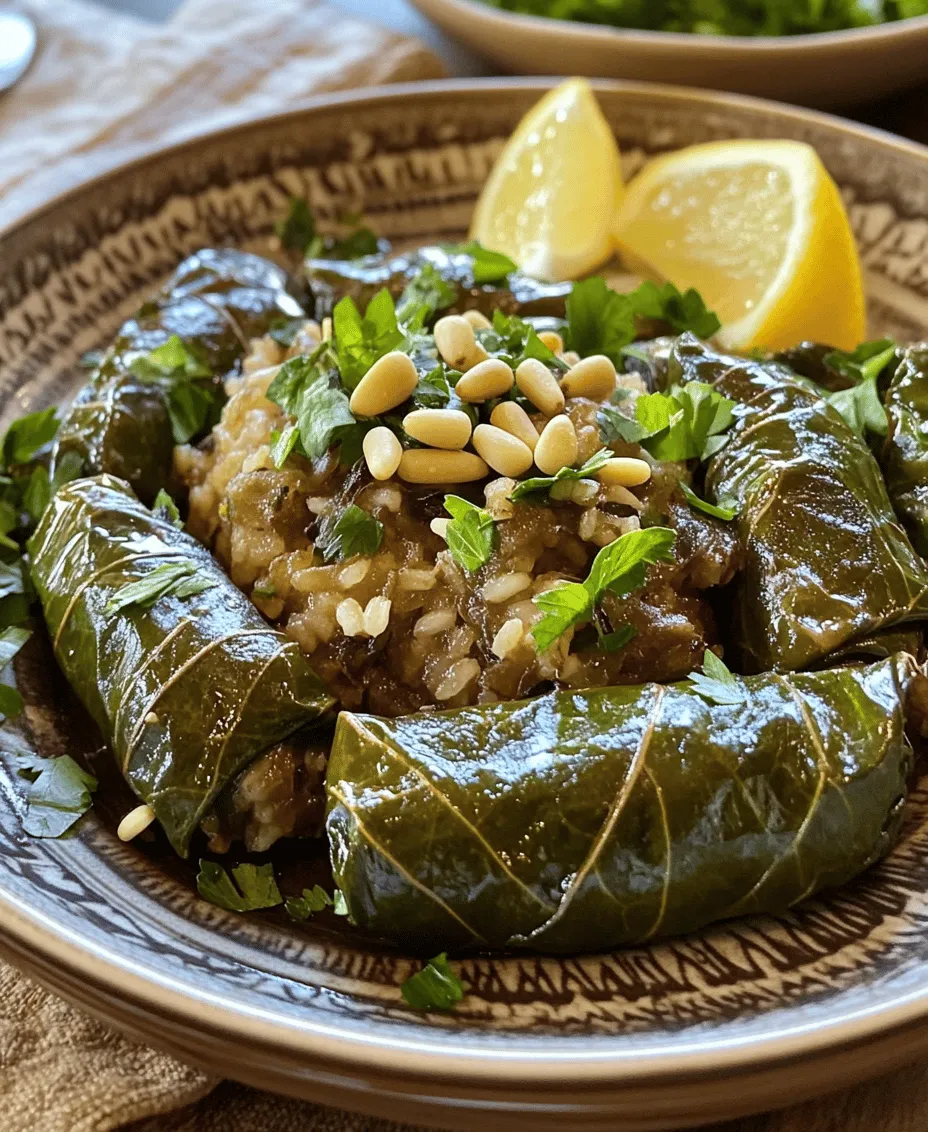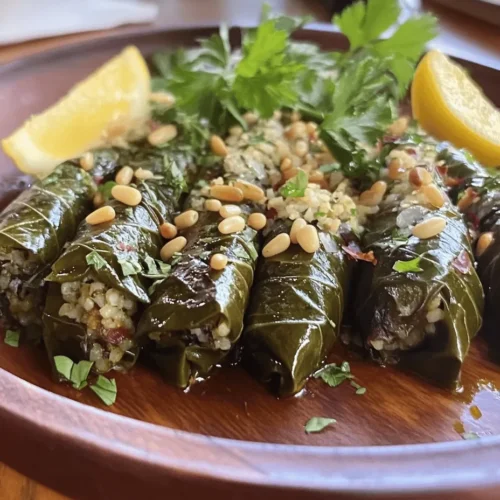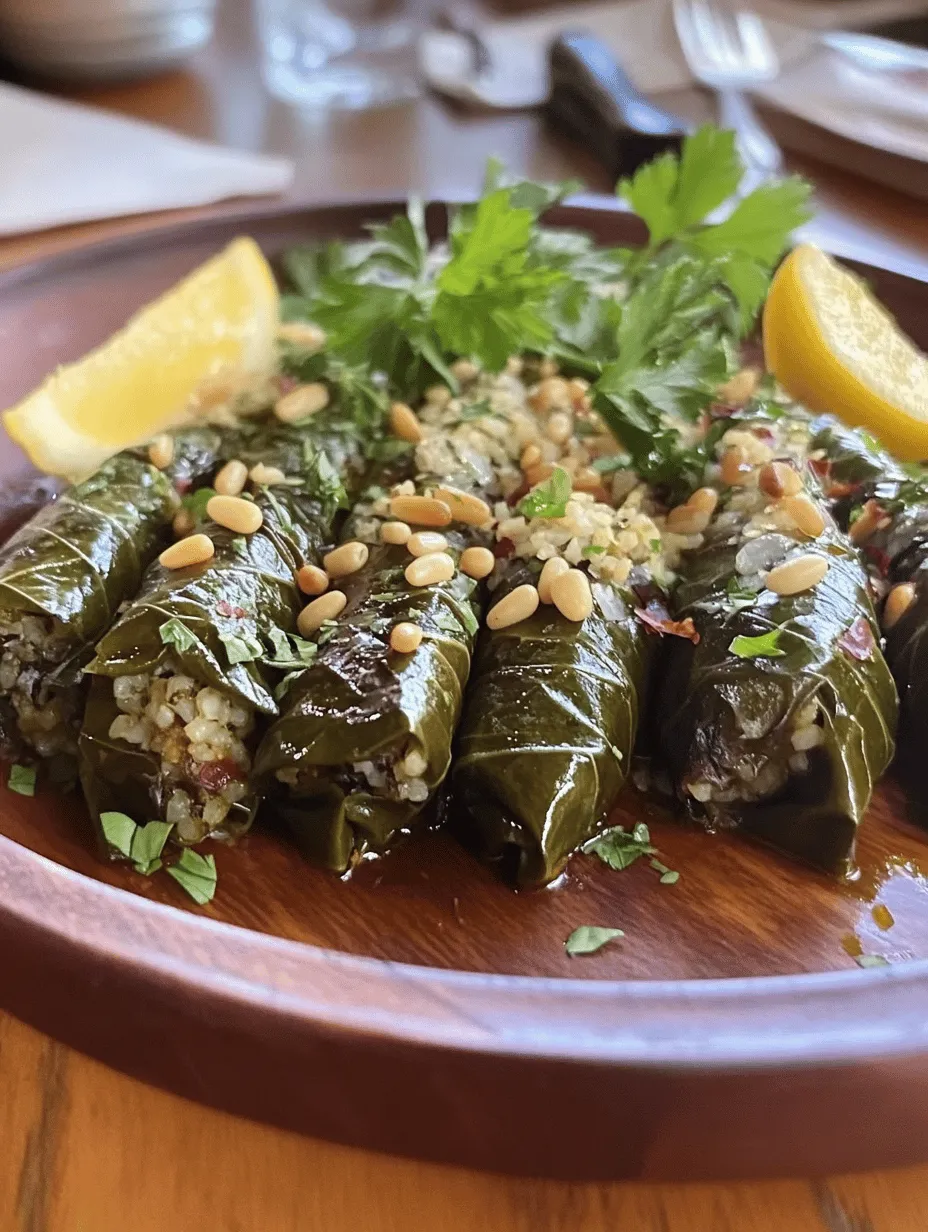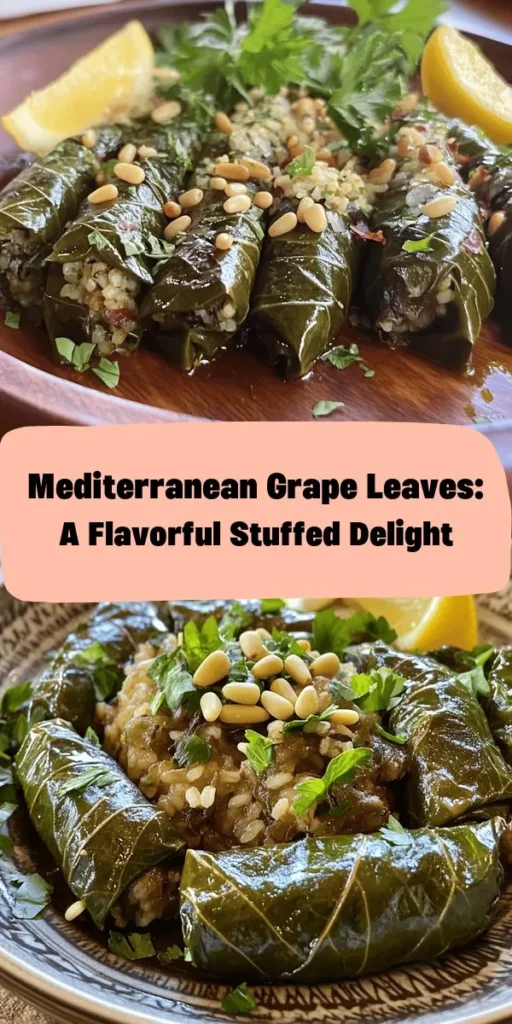Introduction
Mediterranean cuisine is a vibrant tapestry woven from the rich history and diverse cultures of the regions bordering the Mediterranean Sea. Known for its emphasis on fresh ingredients, bold flavors, and wholesome dishes, this culinary tradition celebrates the bounty of nature with a delightful array of vegetables, meats, grains, and herbs. Among the many iconic dishes that represent Mediterranean cooking, stuffed grape leaves—known as Warak Enab—stand out as a beloved delicacy enjoyed across various cultures, from Greece to Lebanon and beyond.
Warak Enab is not just a dish; it is a symbol of hospitality and tradition. These tender grape leaves are elegantly wrapped around a savory filling, often made from rice, herbs, and spices, creating bite-sized morsels that are as pleasing to the eye as they are to the palate. The versatility of stuffed grape leaves makes them an ideal choice for any occasion—whether served as appetizers at a festive gathering, as a side dish accompanying a main course, or even as a standalone meal. With their delicious flavors and beautiful presentation, Warak Enab is sure to impress both family and friends.
In this article, we will explore the enchanting world of Mediterranean stuffed grape leaves, delving into the origins of grape leaves, the nutritional benefits they offer, and the key ingredients that make this dish shine. We will also guide you through detailed, step-by-step instructions for preparing these delightful treats, ensuring that your culinary experience is both enjoyable and rewarding.
Understanding Grape Leaves
Grape leaves are the edible foliage of the grapevine, typically harvested in the spring and early summer when they are young and tender. These leaves have been used for centuries in Mediterranean cooking, originating from ancient cultures that recognized their culinary potential. The leaves are pliable and have a slightly tangy flavor, making them the perfect vessel for wrapping flavorful fillings.
Nutritionally, grape leaves are a powerhouse of health benefits. They are low in calories yet high in fiber, making them an excellent choice for those seeking a nutritious option. One serving of grape leaves can provide a good source of vitamins A and C, iron, and calcium. Additionally, they are rich in antioxidants, which can help combat free radicals in the body. The use of brined grape leaves is particularly significant in Mediterranean cooking, as the brining process enhances their flavor while preserving their texture, allowing them to withstand the cooking process without losing their integrity.
When preparing Warak Enab, it is essential to choose high-quality grape leaves. Most commonly, these leaves are found in jars or cans, preserved in brine. Properly rinsing and draining the grape leaves before use is crucial, as it helps remove excess salt and allows the natural flavors of the leaves to shine through in the finished dish.
Ingredients for Mediterranean Stuffed Grape Leaves
To create delightful Mediterranean stuffed grape leaves, you will need a selection of fresh and flavorful ingredients. Here’s a detailed list of what you will need, along with explanations of their significance in the dish:
– Grape leaves in brine: As the star ingredient, grape leaves provide the perfect wrap for the filling. When selecting grape leaves, opt for those that are tender and free from blemishes. Rinse them thoroughly under cold water to eliminate excess salt and then set them aside to drain.
– Long-grain rice: This type of rice is preferred for stuffed grape leaves due to its ability to remain fluffy and separate after cooking. The texture of long-grain rice complements the filling, providing a pleasant bite without becoming mushy.
– Fresh herbs: Parsley and mint are essential herbs that elevate the flavor profile of the filling. Parsley adds a bright, fresh note, while mint contributes a subtle sweetness that balances the dish.
– Pine nuts: Although optional, pine nuts add a delightful crunch and nutty flavor to the filling. When toasted lightly, they enhance the overall taste and texture of the stuffed grape leaves.
– Spices: A blend of allspice and cinnamon is often used in Mediterranean dishes, imparting warmth and depth to the filling. These spices create a comforting aroma and flavor that complements the other ingredients beautifully.
– Broth: The choice of broth—vegetable or chicken—can significantly impact the flavor of the dish. Vegetable broth is a great option for a lighter taste, while chicken broth adds richness and depth.
– Lemon juice: Fresh lemon juice is crucial for balancing the flavors in the dish. The acidity brightens the filling, enhancing the overall taste of the stuffed grape leaves.
Step-by-Step Instructions for Preparing Delightful Mediterranean Stuffed Grape Leaves
Preparation of the Filling
The preparation of the filling is a crucial step in creating delicious stuffed grape leaves. The filling typically consists of rice, herbs, nuts, and spices, all blended together to form a harmonious mixture.
1. Sautéing Onions: Begin by finely chopping one medium onion. In a large skillet, heat a couple of tablespoons of olive oil over medium heat. Add the chopped onions and sauté them until they become translucent and fragrant, about 5-7 minutes. This step enhances the flavor of the filling, creating a savory base that complements the other ingredients.
2. Cooking Rice: While the onions are sautéing, rinse one cup of long-grain rice under cold water until the water runs clear. This step removes excess starch and prevents the rice from becoming sticky. Once rinsed, add the rice to the skillet with the sautéed onions, stirring to coat the rice in the oil. Add two cups of broth (vegetable or chicken) and bring the mixture to a simmer. Reduce the heat to low, cover the skillet, and let the rice cook for about 15 minutes, or until the liquid is absorbed and the rice is tender. Fluff the rice with a fork and let it cool slightly.
3. Combining Ingredients: In a large mixing bowl, combine the cooked rice, sautéed onions, a handful of chopped fresh parsley, a few tablespoons of chopped fresh mint, and a handful of toasted pine nuts if using. Season the mixture with salt, pepper, a teaspoon of allspice, and a pinch of cinnamon. Add the juice of one lemon and mix everything thoroughly. Allow the filling to cool completely before proceeding to stuff the grape leaves. This step is essential as it prevents the grape leaves from tearing and ensures a well-formed roll.
4. Stuffing the Grape Leaves: To prepare the grape leaves for stuffing, lay a leaf flat on a clean surface, with the vein side facing up. Place about a tablespoon of the filling near the stem end of the leaf. Fold the sides of the leaf over the filling, then roll it tightly from the stem end toward the tip, creating a neat and compact package. Repeat this process with the remaining grape leaves and filling, placing the stuffed rolls seam-side down in a large pot or baking dish.
This is just the beginning of your journey to creating delightful Mediterranean stuffed grape leaves. As you progress through the cooking process, you’ll discover the rich flavors and textures that make Warak Enab a cherished dish in Mediterranean kitchens. Stay tuned for the next steps, where we will explore the cooking process and how to serve your delicious creations!

Detailed Guide on How to Roll Grape Leaves Properly
Rolling grape leaves may seem daunting at first, but with practice, it becomes a skill that enhances your cooking repertoire. To start, rinse the grape leaves under cold water to remove any brine or salt. Lay a leaf flat on a clean surface, with the shiny side down. Place a spoonful of the filling (about 1 tablespoon) at the base of the leaf, leaving enough space at the edges for folding.
To roll the grape leaf, begin by folding the bottom edge of the leaf over the filling. Then, fold in the sides to enclose the filling securely. Finally, roll the leaf away from you towards the top, ensuring that the filling is tightly wrapped. The goal is to create a tight cylinder that prevents the filling from escaping during cooking. Repeat this process with the remaining leaves and filling, placing the rolled leaves on a plate as you go.
Tips for Creating a Tight Cylinder and Ensuring No Filling Escapes
Achieving a tightly rolled grape leaf is crucial for a successful dish. Here are some tips to ensure your rolls are perfect:
1. Use the Right Amount of Filling: Overfilling can lead to bursting during cooking. Aim for about a tablespoon of filling per leaf, adjusting based on the size of the leaf.
2. Tuck and Roll: When you fold in the sides, make sure to tuck them firmly against the filling before rolling up. This creates a secure closure.
3. Moisture Management: If you notice that the filling is too wet, the leaves may not hold together well. Consider reducing any liquid ingredients in the filling slightly.
4. Practice: Like any cooking technique, rolling grape leaves improves with practice. Consider making a few test rolls to refine your technique before tackling a larger batch.
Arranging the Stuffed Leaves in the Pot
Once you have rolled all your grape leaves, it’s time to arrange them in the pot for cooking. Proper layering is essential to avoid sticking and ensure even cooking.
1. Layering Technique: Start by placing a few unrolled grape leaves or slices of lemon at the bottom of the pot. This prevents the stuffed leaves from sticking to the bottom and adds flavor during cooking.
2. Pack Tightly: Arrange the stuffed grape leaves seam-side down, packing them tightly together. This not only helps them maintain their shape but also allows them to steam properly, enhancing the flavor.
3. Visual Cues: As you layer the grape leaves, try to keep them in a single layer rather than stacking them too high. If you have a larger batch, consider using a larger pot to spread them out. Look for a snug fit, as this promotes even cooking and prevents gaps where steam could escape.
Cooking the Stuffed Leaves
Cooking the stuffed grape leaves is where all the flavors meld together. Begin by adding enough water or broth to cover the grape leaves completely. You can also add a splash of lemon juice for an extra zing.
1. Simmering Process: Bring the pot to a gentle simmer over medium heat. Once simmering, reduce the heat to low and cover the pot. Let the grape leaves cook for about 45 minutes to an hour. The steam will help soften the leaves and cook the filling.
2. Check for Doneness: To check if the grape leaves are done, carefully lift one from the pot. The rice should be tender and the leaves should be vibrant green and pliable. If the rice is still hard or crunchy, return the pot to the heat and continue cooking for another 10-15 minutes, checking periodically.
3. Resting Period: Once cooked, let the stuffed grape leaves sit in the pot for about 10-15 minutes before serving. This resting period allows the flavors to settle and makes them easier to handle.
Serving Suggestions for Stuffed Grape Leaves
When it comes to serving your Mediterranean stuffed grape leaves, presentation can elevate the dish from home-cooked to restaurant-worthy.
– Plating Ideas: Arrange the stuffed leaves on a large platter, drizzling them with olive oil and a sprinkle of fresh herbs like parsley or mint. You can also garnish with lemon wedges for added acidity.
– Ideal Accompaniments: Stuffed grape leaves pair wonderfully with a side of yogurt or tzatziki for dipping. A fresh salad with tomatoes, cucumbers, and feta complements the dish beautifully, adding a refreshing contrast.
– Cultural Variations: In some cultures, stuffed grape leaves are served with a side of pilaf or hummus, showcasing the versatility of the dish. Consider exploring different regional accompaniments to enrich your dining experience.
Cultural Significance of Warak Enab
Stuffed grape leaves, or Warak Enab, hold a special place in Mediterranean cuisine and culture. Traditionally served at family gatherings and festive occasions, they symbolize hospitality and togetherness.
– Celebratory Dish: In many Mediterranean cultures, preparing stuffed grape leaves is a communal activity. Family members often gather to roll the leaves together, sharing stories and laughter in the process. This makes the dish not just a meal, but a cherished tradition.
– Regional Variations: The dish has numerous variations across different cultures. In Turkey, for example, stuffed grape leaves may include minced meat as a filling, while in Greek cuisine, they are often served with a lemony avgolemono sauce. Lebanese versions may incorporate spices like cinnamon and allspice, showcasing the diversity of flavors across the Mediterranean.
– Personal Anecdotes: Many families have their own unique recipes passed down through generations, each with its own story. Perhaps your grandmother had a secret ingredient, or a family gathering always featured stuffed grape leaves as the star of the meal.
Health Benefits of Mediterranean Stuffed Grape Leaves
Beyond their delicious taste, Mediterranean stuffed grape leaves are packed with nutritional benefits, making them a wholesome choice for any meal.
– Nutritional Profile: The primary ingredients, including rice, herbs, and spices, provide vitamins and minerals. Grape leaves themselves are low in calories and high in fiber, making them a healthy addition to your diet.
– Mediterranean Diet Benefits: Embracing a Mediterranean diet is linked to numerous health benefits, including reduced risk of heart disease and improved longevity. The emphasis on fresh produce, healthy fats, and whole grains contributes to overall well-being.
– Vegan and Vegetarian-Friendly: Stuffed grape leaves can easily be adapted to suit various dietary preferences. With a filling made primarily of rice, herbs, and spices, they are naturally vegetarian and can be made vegan by omitting any animal products.
Conclusion
Mediterranean stuffed grape leaves are a delightful dish that offers a taste of the region’s rich culinary heritage. Their versatility allows for endless variations, making them suitable for any occasion, from casual family dinners to festive celebrations. Making stuffed grape leaves at home is not just about the final dish, but also about the joy of cooking and sharing with loved ones.
As you embark on this culinary adventure, you’ll discover the beauty of Mediterranean cuisine and the satisfaction of creating something truly special from scratch. So gather your ingredients, invite your friends or family to join in the preparation, and enjoy the process of making and sharing these delicious homemade stuffed grape leaves. With each bite, you’ll not only savor the flavors but also the stories and traditions that make this dish a beloved favorite across generations.



